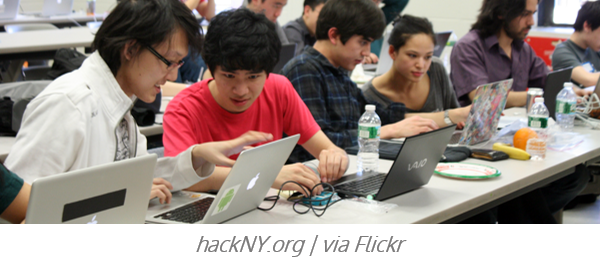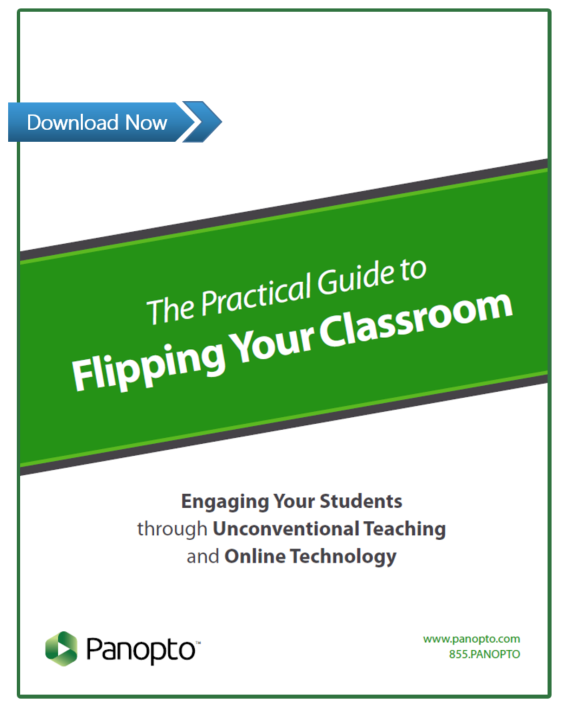- Academic Technology
Making the Most of Your Flipped Classroom’s In-Class Time
For first-time flippers, it can be easy to get wrapped up in the initial challenges of planning and producing pre-class lecture materials, and lose sight of what that up-front effort earns you. When you walk into your flipped classroom, you’ll have a room full of informed students, ready to dig in and explore the day’s lesson together with you.
 This is arguably the element of the flipped classroom most essential to long-term success. Done well, the interactive class time you’ve cultivated by flipping will justify itself in improved student participation, interaction, and performance.
This is arguably the element of the flipped classroom most essential to long-term success. Done well, the interactive class time you’ve cultivated by flipping will justify itself in improved student participation, interaction, and performance.
Yet, achieving that student-centered learning experience isn’t a given. Just as an instructor needs to prepare for the work of providing lecture materials ahead of time, teachers in flipped classrooms must plan for how they’ll make the most of their newly-structured in-class hours.
Depending on the subject and how the students in the classroom learn best, there is almost no limit to the number of ways instructors can structure their flipped class time for maximum interactivity and learning.
Let’s look into some of the most common types of flipped classroom structures:
The Inverted Classroom
Students are assigned the “homework” of watching video lectures and reading any materials relevant to the next class. During class time, students practice what they’ve learned through traditional schoolwork, with their teachers freed up for additional one-on-one time.
Case-based Learning
Students prepare before class, and are assigned to small groups at the beginning of class time. Groups analyze a given problem or assignment and present a solution or recommended course of action. Teachers act as guides during class, engaging groups to suggest approaches or answer questions.
Guided Inquiry Learning
Students review materials before class. In-class activities are Socratic in nature, guided by questions from the instructor and designed to encourage students to explore concepts or information, draw conclusions, and apply the concepts.
Team-based Learning
Students prepare before class and are quizzed over the content at the start of class (either as individuals or as teams). Students are given immediate feedback on their performance, and educators tailor the day’s lessons as needed with in-class microlectures to address gaps in understanding. Finally, students are assembled into teams for structured discussions or activities based on lecture content.
Discussion-based Learning
Teachers assign lecture videos, as well as any other video or reading related to the day’s subject, such as TED Talks, YouTube videos, and other resources. Class time is then devoted to discussion and exploration of the subject. This can be an especially useful approach in subjects where context is everything, such as history, art, or English.
Demonstration-based Learning
Subjects like chemistry, physics, and math often require students to remember and repeat activities precisely. In these courses, it’s most helpful to have a video demonstration to be able to rewind and watch again and again. In the demonstration-based model, the teacher uses screen recording software to demonstrate the activity in a way that allows students to follow along at their own pace.
Peer Instruction
Students prepare for class and simply inform the teacher as to what they found confusing or difficult. Class time features a mix of mini-lectures and peer interaction, either with the class as a whole or with smaller groups, depending on the subject matter. Peer instruction deliberately avoids asking students to raise hands to answer questions, and instead insists that students openly discuss questions and work out answers together to achieve better understanding.
The Faux-Flipped Classroom
This is a great idea for younger students, in which actual homework might not yet be appropriate. In the faux-flipped model, students watch lecture video in class, giving them the opportunity to review materials at their own pace. The teacher moves from student to student, offering whatever individual support each young learner needs.
The Virtual Flipped Classroom
For older students and in some courses, the flipped classroom can eliminate the need for classroom time at all. Some college and university professors now share lecture videos for student viewing, assign and collect work via online learning management systems, and simply require students to attend office hours or other regularly scheduled time for brief one-on-one instruction based on that individual student’s needs.
Flipping the Teacher
All the video created for a flipped classroom doesn’t have to begin and end with the teacher. Students, too, can make use of video to better demonstrate proficiency. Assign students to record practice role-play activities to show competency. Or ask each to film themselves presenting a new subject or skill as a means to “teach the teacher.” These materials can then be reviewed and discussed during class time.
Find out more about the flipped classroom
 While every flipped classroom is a little bit different, the goal is always the same: interactive, student-centered learning. To achieve that, flipped classroom time can take many forms, including small group labs, discussions, and problem-solving time, further exploration of the lesson as a group, students presenting and receiving feedback from their peers, or simply time given to complete individual assignments with an opportunity to work more closely with the teacher.
While every flipped classroom is a little bit different, the goal is always the same: interactive, student-centered learning. To achieve that, flipped classroom time can take many forms, including small group labs, discussions, and problem-solving time, further exploration of the lesson as a group, students presenting and receiving feedback from their peers, or simply time given to complete individual assignments with an opportunity to work more closely with the teacher.
Interested in joining teachers from around the country at the forefront of the flipped classroom pedagogy? We’ve prepared a comprehensive guide to preparing, delivering, and evaluating your flipped classroom, from ideas for interactive classroom activities to the tech needed to produce recorded lessons.




